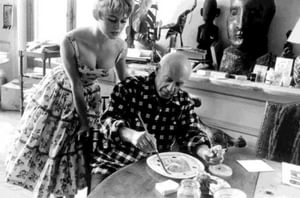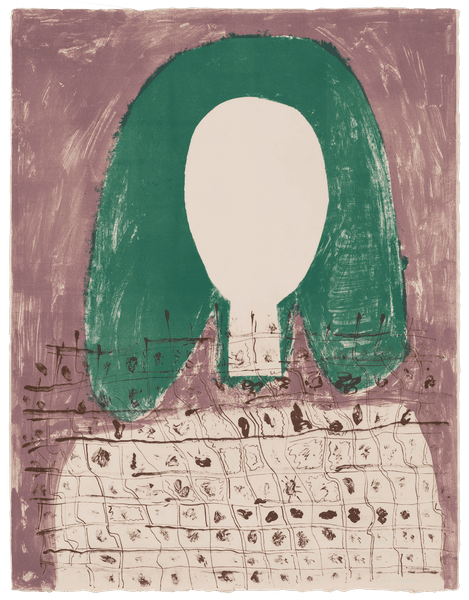Pablo Picasso
With his revolutionary approaches to modes of representation and creation in paintings, sculptures, ceramics, drawings, collages, and prints that contributed to several art movements, including Cubism and Surrealism, Pablo Picasso is regarded as one of the most influential artists of the 20th century.
Born in 1881 in Málaga, Spain, Picasso learned drawing and painting from his father, who was also an artist. His talent was recognised at an early age, leading him to be admitted to the Barcelona School of Fine Arts at 14. By 1897, he had enrolled to study at the Real Academia de Bellas Artes de San Fernando in Madrid. Early paintings such as First Communion (1896), which depicts his sister Lola kneeling before the altar, reveal his mastery of perspective and lighting. Despite his education, however, he was dissatisfied with the academic system, instead frequenting The Prado Museum to familiarise himself with the works of artists such as El Greco, Francisco Goya, Diego Velázquez, and Francisco de Zurbarán.
Picasso left Spain for Paris in 1900, but returned not long after, visiting again for extended periods in 1901 and 1902. During the so-called 'Blue Period' (1901–1904), he portrayed subjects living on the margins of society—the poor, prostitutes, vagrants—with a palette of mainly blue, fostering an air of melancholy. He often depicted his figures with elongated limbs and sombre expressions, not only adding to the blue tone of his works but also recalling the solemn saints found in El Greco's paintings.
After relocating to Paris in 1904, Picasso found better prospects, including the patronage of American art collector and writer Gertrude Stein. In the years known as the 'Rose Period' (1904–1906), he primarily painted with varieties of pink and moved to Montmartre, a district populated by entertainers. One of his best-known paintings, Boy with a Pipe (1905) shows a lean boy dressed in blue, holding a pipe and wearing a garland; behind him is an orange background with pink and white flowers.
Picasso also began to experiment with elements of ancient Iberian and African culture. Early examples include Portrait of Gertrude Stein (1905), in which Stein appears seated with a mask-like face. In 1907, he completed Les Demoiselles d'Avignon, a large oil painting featuring five naked women composed of bold shapes and simple, angular masses evocative of African art. The profile of the figure on the left, for example, evokes ancient Egyptian portraiture. The artist also drew from the ancient Iberian sculpture he had seen at the Louvre and an African mask that his friend Henri Matisse owned. While his close friends and the art world reacted negatively at first, Les Demoiselles d'Avignon came to be recognised for its radical departure from figurative painting—especially idealised female beauty—as it was understood by academic painting at the time.
Picasso's subsequent stylistic changes can be found in his representation of human figures over the decades. In paintings such as Portrait of Ambroise Vollard (1910) and Ma Jolie (1911–1912), human forms are almost unrecognisable, having been segmented into intersecting planes and lines. This approach is characteristic of Cubism, a style he and his fellow painter Georges Braque invented around 1907, exploring new ways of representing reality by using multiple viewpoints.
In 1912, Picasso introduced the element of collage to his work, incorporating materials such as newspaper advertisements, wallpaper, and wickerwork. The early 1920s saw him briefly paint in the Neoclassical fashion, returning to figurative representation with paintings such as Woman in White (1923), while Nude Standing by the Sea (1929) shows the influence of Surrealism with a female nude composed of geometric limbs and a curved body.
In the 1930s Picasso began to portray figures with inventively sinuous contours, rendering these distortions in bold colours or monochrome. Guernica (1937)—a large mural painting created in reaction to the Nazi bombing of the town of Guernica during the Spanish Civil War—depicts the horrors of war through contorted human bodies and animals. Many of his post-War works directly reference canonical paintings in Western art history—in both titles and compositions—such as Las Meninas (1957), after Velázquez, or Luncheon on the Grass (1961), after Edouard Manet.
Picasso was the first great 20th-century art world star. He was inventiveness personified, a poet and an intellectual: a wealthy celebrity greatly admired for his phenomenal drawing skills but also, posthumously, criticised for his poor treatment of his wives and lovers. After a long and extraordinarily creative life he died in Mougins, France, in 1973.
Featured Artists
- Albers Anni
- Ancart Harold
- Andre Carl
- Avery Milton
- Baldessari John
- Barnes Ernie
- Calder Alexander
- Castellani Enrico
- Clough Prunella
- Crawford Brett
- Dadamaino
- de Tollenaere Saskia
- Dyson Julian
- Elsner Slawomir
- Freud Lucian
- Gadsby Eric
- Gander Ryan
- Guston Philip
- Haring Keith
- Hartung Hans
- Hayes David
- Held Al
- Hepworth Barbara
- Hill Anthony
- Hitchens Ivon
- Hockney David
- Hutchinson Norman Douglas
- Jenney Neil
- Katz Alex
- Kentridge William
- Knifer Julije
- Kusama Yayoi
- Le Parc Julio
- Leciejewski Edgar
- Léger Fernand
- Levine Chris
- Marchéllo
- Martin Kenneth
- Mavignier Almir da Silva
- Miller Harland
- Mitchell Joan
- Modé João
- Moore Henry
- Morellet François
- Nadelman Elie
- Nara Yoshitomo
- Nesbitt Lowell Blair
- Nicholson Ben
- O'Donoghue Hughie
- Pasmore Victor
- Perry Grayson
- Picasso Pablo
- Pickstone Sarah
- Prehistoric Objects
- Riley Bridget
- Ruscha Ed
- Sedgley Peter
- Serra Richard
- Shrigley David
- Smith Anj
- Smith Richard
- Soto Jesús Rafael
- Soulages Pierre
- Spencer Stanley
- Taller Popular de Serigrafía
- The Connor Brothers
- Vasarely Victor
- Vaughan Keith
- Whiteread Rachel
- Wood Jonas

